On Saturday night, Ernesto Valverde recorded his fourth La Liga defeat as Barcelona manager after a total of 74 games managing the Blaugrana team. That makes just a bit over five percent of all his matches in the Spanish top division and so far, it makes him the most proficient Barcelona boss of them all.
But in a way, this defeat was somewhat an expected turn of events at the Balaídos stadium and against a highly motivated Celta Vigo team on the other side of the pitch. This tactical analysis will attempt to dissect how a depleted champions’ team fell in Vigo and how their hosts made that happen.
Lineups
Barcelona (4-3-3)
Starting XI: Cillessen – Wagué, Todibo, Umtiti, Vermaelen – Puig, Arthur, Aleña – Dembélé, Prince, Malcom
Bench: Iñaki Peña, Lenglet, Murillo, Semedo, Vidal, Coutinho, Collado
Coach: Ernesto Valverde
Celta Vigo (4-4-2)
Starting XI: Rubén – Hugo Mallo, Araújo, Cabral, Olaza – Okay, Lobotka, Boudebouz, Boufal – Maxi Gómez, Iago Aspas
Bench: Sergio, Costas, Beltrán, Sisto, Hjulsager, Jozabed, Méndez
Coach: Francisco Escribá
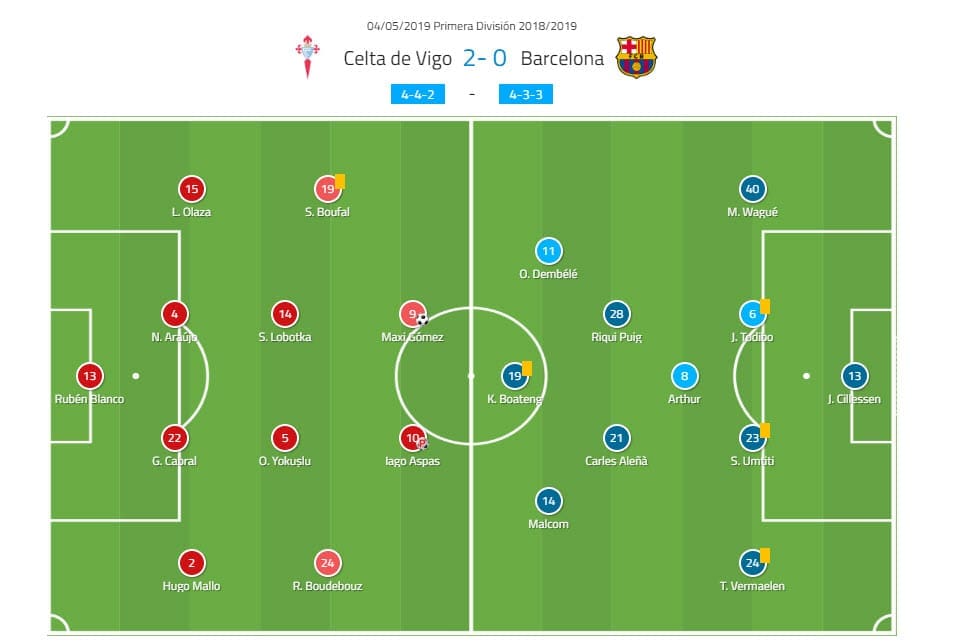
Barcelona’s setup
With the La Liga title already in the bag for Barcelona, Ernesto Valverde had no reason to sacrifice any of his usual starters in a more or less meaningless game. However, it was not meaningless for all the youngsters and other players aching for some minutes in the competition.
For those reasons and with the return leg at Anfield against Liverpool next week in mind, the likes of Lionel Messi, Luis Suárez, Jordi Alba, Ivan Rakitić, Sergio Busquets, and Gerard Piqué were left at home to rest and in came a surge of new blood with La Masia graduates stepping up to face the music.
Jasper Cillessen was in between the sticks so he could get some game rhythm before the Copa del Rey final against Valencia, while the young Moussa Wagué and Jean-Clair Todibo accompanied Thomas Vermaelen and Samuel Umtiti in the backline. The midfield was composed of Arthur Melo, Riqui Puig and Carles Aleña while Kevin-Prince Boateng, Ousmane Dembélé and Malcom manned the frontier.
The team operated in a 4-3-3 system throughout the whole game in Vigo.
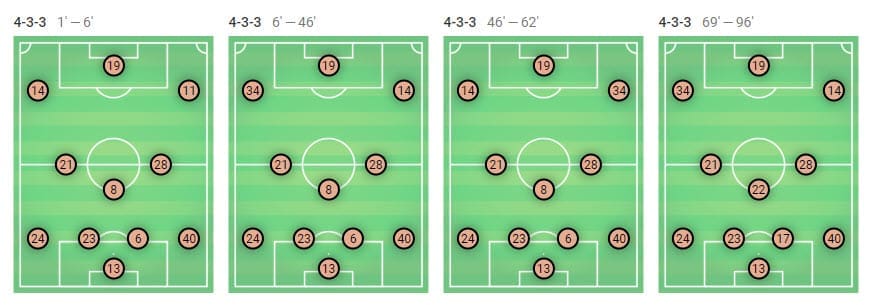
Celta Vigo’s setup
As opposed to their Catalan counterparts, the boys from Celta Vigo are still not finished with their campaign and every point counts towards their journey to safety. The Balaídos was never a pleasant place for Barcelona and knowing they would most likely face a depleted Catalan squad, the hosts could not risk it with too many changes to their usual lineup.
The whole backline, including the goalkeeper between the sticks, was therefore unchanged with Rubén Blanco guarding the net with Lucas Olaza, Néstor Araújo, Gustavo Daniel Cabral and Hugo Mallo forming the quartet in the back. The midfield, however, saw some changes as Okay Yokuslu and Ryad Boudebouz came in alongside Lobotka and Boufal.
The usual suspects were seen up front. Maxi Gómez and Iago Aspas led the Celta Vigo lines against the already crowned champions of Spain in a 4-4-2 formation that was not mettled with throughout the whole 90 minutes.
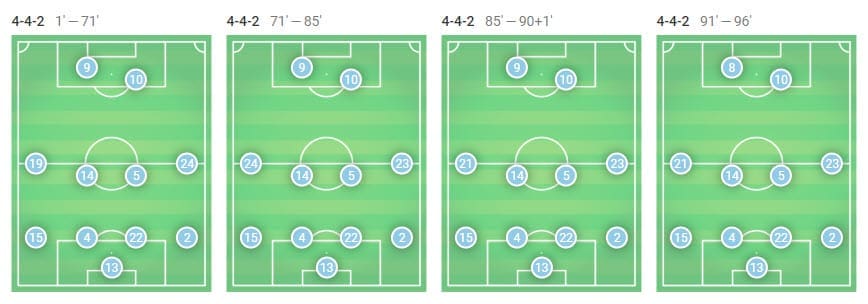
Barcelona’s youngsters show quality
Even though Barcelona deployed a rather young team who were more or less thrown into the fire, the youngsters did extremely well for themselves. The first half of the game was goalless but Barcelona were dominant, more so than not, in their approach but their possession proved to have been without any edge or penetration.
Celta Vigo knew they could count on the less experienced Catalan legs giving away the ball more times than usual so they faced their opponents head-on, pressing extremely high from the very beginning of the match in Vigo.

Seeing how that would be the case, Barcelona had to find ways of bypassing that press and continuing the build-up as planned. In a standard setup, two Blaugrana midfielders were positioned higher up the pitch, while one, in this case Arthur Melo, played as a pivot deeper down the lane.
When they were pressed and the ball circulated all the way to the backline, Barcelona would usually drop two midfielders to assist the progress of the ball, as seen in the image above. That way they could achieve the numerical superiority and outnumber the opposition, leaving them with multiple open passing channels to get out of a sticky situation.
After their press was broken and Barcelona made their way into the opposition’s half, Celta Vigo would revert to their 4-4-2 medium and narrow block to stop the ball circulation, as seen in the example below. The reason why they could allow themselves such a narrow shape was the absence of Jordi Alba and the lack of a speedy option for an overlap.
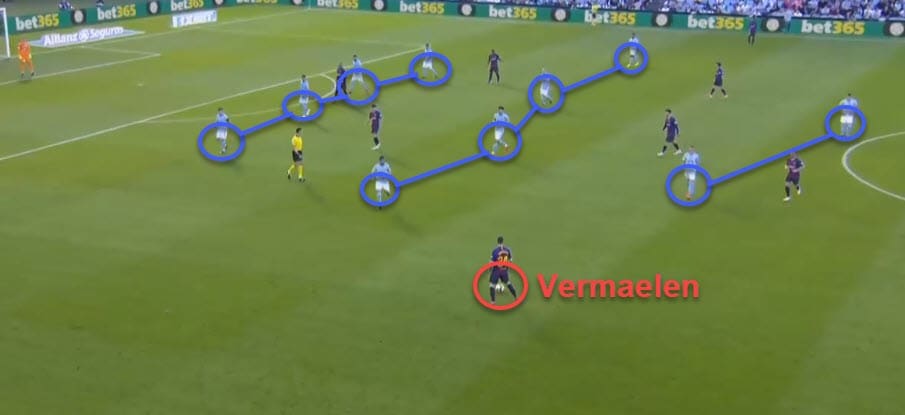
With Thomas Vermaelen being the team’s left-back, their offensive prowess down that flank diminished significantly as the Belgian defender would not really venture up the pitch, and would never over or underlap with Barcelona’s wingers. This made Celta Vigo’s job a lot easier but their pressing a bit more difficult to successfully deploy.
Gomez and Aspas would still press and were assisted by the midfield quartet who would look to collapse on the ball-carriers but the away team used the same tools to once again avoid the press and retain the possession. The midfielders would drop only slightly to help the backline with additional passing options.
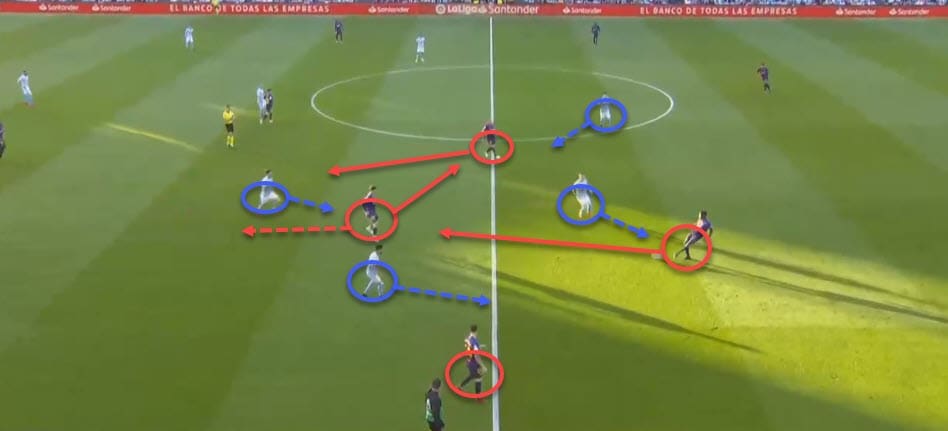
Usually, it would be Puig and Arthur combining around the centre of the park in order to carry the ball into the final third. Even though the Brazilian was the team’s pivot, the young La Masia prodigy would often drop deeper to orchestrate play himself. As the left side was devoid of any real attacking threats bar their wingers, using Moussa Wagué on the right was their somewhat preferred choice when going forward.
It was interesting to see how Celta Vigo pilled men on the side where the ball was, trying to suffocate the opposition. Barcelona reacted in a similar manner, pulling both their striker and the opposite flank’s winger to combat the home team’s attempt at overloads.
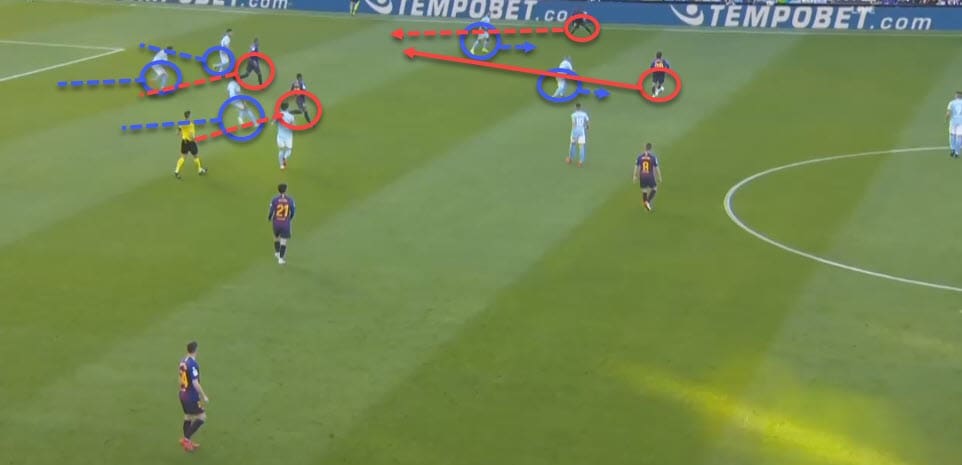
Even though the example above ends up in Celta Vigo clearing the ball, Barcelona managed to play around their narrow shape, manipulating their opposition to create pockets of free space to exploit. This was their biggest weapon but for all their efforts, there was not enough penetration or cutting edge to draw first blood.
If we take a look at their possession stats, it seems like they were able to mostly control the game and dictate play regardless of their age. Celta Vigo, on the other hand, created a lot more, especially when we consider their average possession on the night, which was really low.
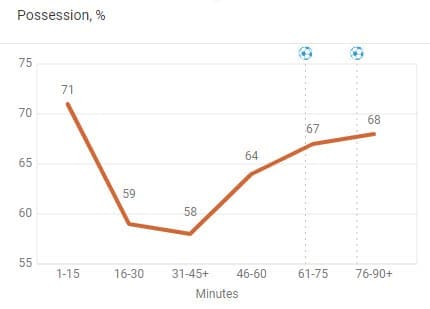
Celta Vigo had a clear gameplan
While Barcelona tried relying on intricate passing and waiting for a chance to pop up, Celta Vigo had a more direct approach in mind. They could always rely on their striker up front in Iago Aspas as the experienced frontman, or his partner in crime Maxi Gómez, who would often slip behind the defence or exploit their blind spots to get to the ball first.
This indeed did yield them the first goal to put the hosts in front but it was also creating numerous chances throughout the game. That part of the plan was clear: funnel passes up front and let either Aspas or Maxi Gómez win the first ball that sets the play into motion. As a result, Celta Vigo won 14 aerial duels as opposed to Barcelona’s nine. Gómez himself won almost half of those all alone (six).
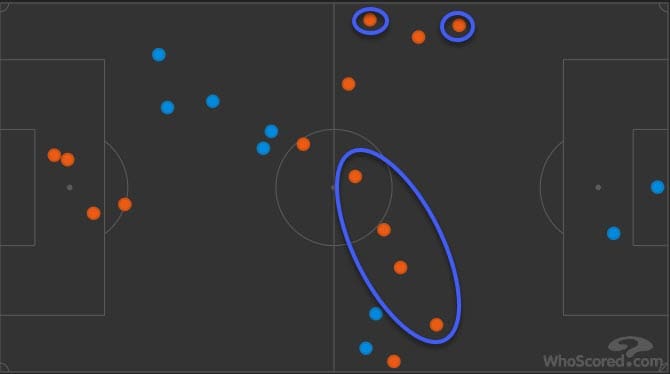
Winning the first ball was crucial in their progress into the final third. With Barcelona’s squad a lot younger than usual, they pressed and counter pressed with more intensity than on most days. Sometimes it meant that Celta Vigo would have to resort to long balls even though they faced a much less experienced Catalan side.
Below is one of the examples of how they would successfully transition the ball further up the pitch, starting with a distribution from the man in between the sticks. Rubén Blanco aims for Gómez, who wins the aerial duel and sends the attack into motion.

And with just a couple of quick moves, Celta Vigo advance into Barcelona’s final third with pace, bypassing the pressing squad as well as all the collapse attempts by the visitors. Most of their chances would, in fact, stream through the flanks and would start with crosses into the box.

On the night, they managed a total of 16, which is more than the 14.91 they average and an overwhelming number of those were deployed from the right side (69%), targeting Barcelona’s slower flank where they could get into good positions to send the balls towards their target-men more easily.
But other than exploiting their aerial advantage, they also managed to take advantage of Barcelona’s sloppiness in recycling possession without any consequences. While the Catalan team is usually extremely safe on the ball, this younger iteration of their squad had a bit less success in that department, resulting in a total of 92 losses and 56 recoveries for Celta Vigo.

It’s also worth noting that four of the losses lead directly to a shot on goal for the hosts and from five of the counterattacks Celta Vigo managed to orchestrate, three yielded an attempt on target. These transitions were deadly for Barcelona as they could not match that intensity going back, which is usually the bane of the Catalan team, both with their senior players and it seems like the younger version did not fare that much better.
Finally, Celta Vigo created chances by quickly swapping sides and drifting into wide crossing areas with their flexible attacking approach. What I mean by this is that their players would often play out of their natural positions in order to shuffle Barcelona’s defence and unlock it. In the example below, Boudebouz is firstly positioned higher since his team is in a quick transition but then drops deeper to drag multiple markers with him.
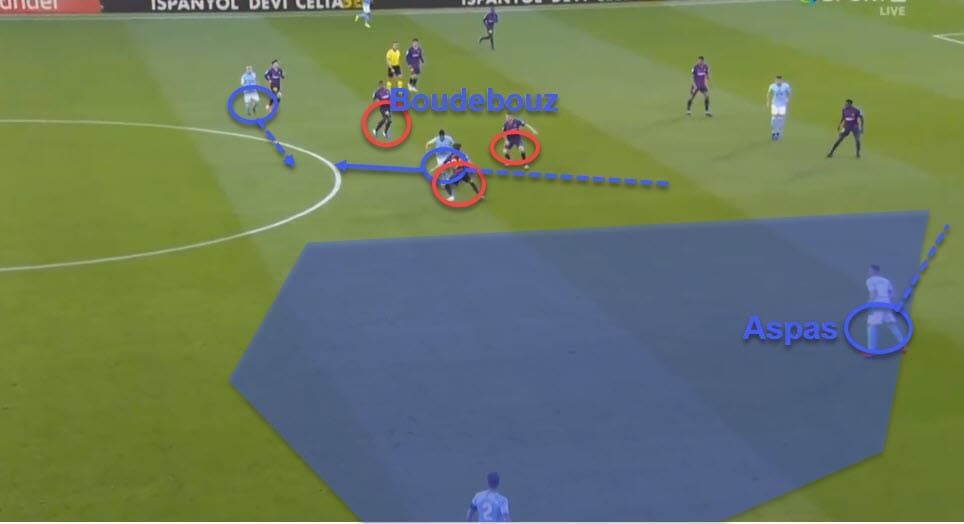
Another important thing to notice is how Iago Aspas follows suit, assuming a deeper position in the wide areas on the right side, which is now uncovered by Barcelona’s pressing squad since they had to react in the middle.
A quick swapping of sides forces Barcelona to spread out, leaving the striker in the box with a lot of space and an easier target for an inevitable cross that was much easier to deploy with precision. Unfortunately for the attacking team, Jasper Cillessen was just a bit faster and manages to get to the ball before Gómez can slot it in.
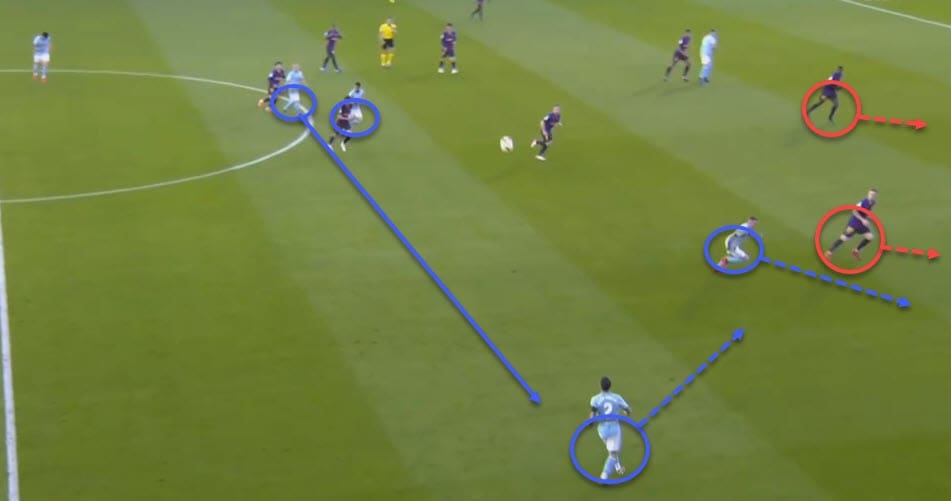
The second goal for Celta Vigo that sealed the three points came after a converted penalty from Iago Aspas which followed after a VAR review from the referee. The experienced 31-year-old striker thus continued his excellent run of form, scoring his seventh in the last five games and 17th this season alone. And it is actually no coincidence that he rattled the Catalans’ net since he has already scored six goals against Barcelona in La Liga, more than any other player since 2014/15.
He truly is the heart and soul of this Celta Vigo team and a huge reason they managed to get a bit closer to staying afloat in La Liga with two games to go until the official end of the 2018/19 campaign.
Conclusion
Celta Vigo have moved a step closer to finishing above the relegation zone in La Liga and Barcelona managed to rest all of their big guns in preparation for the second leg of the Champions League clash with Liverpool, so this game turned out to be a win-win situation for both teams.
The only real concern the Catalans have now is yet another hamstring injury to Ousmane Dembélé but we are yet to find out the extent of it when the medical staff give their report to the club.
To the top dogs, La Liga is long finished and their eyes are set on different targets. Let’s see how everything plays out for the rest of the competitors.
If you love tactical analysis, then you’ll love the digital magazines from totalfootballanalysis.com – a guaranteed 100+ pages of pure tactical analysis covering topics from the Premier League, Serie A, La Liga, Bundesliga and many, many more. Buy your copy of the April issue for just ₤4.99 here, or even better sign up for a ₤50 annual membership (12 monthly issues plus the annual review) right here.

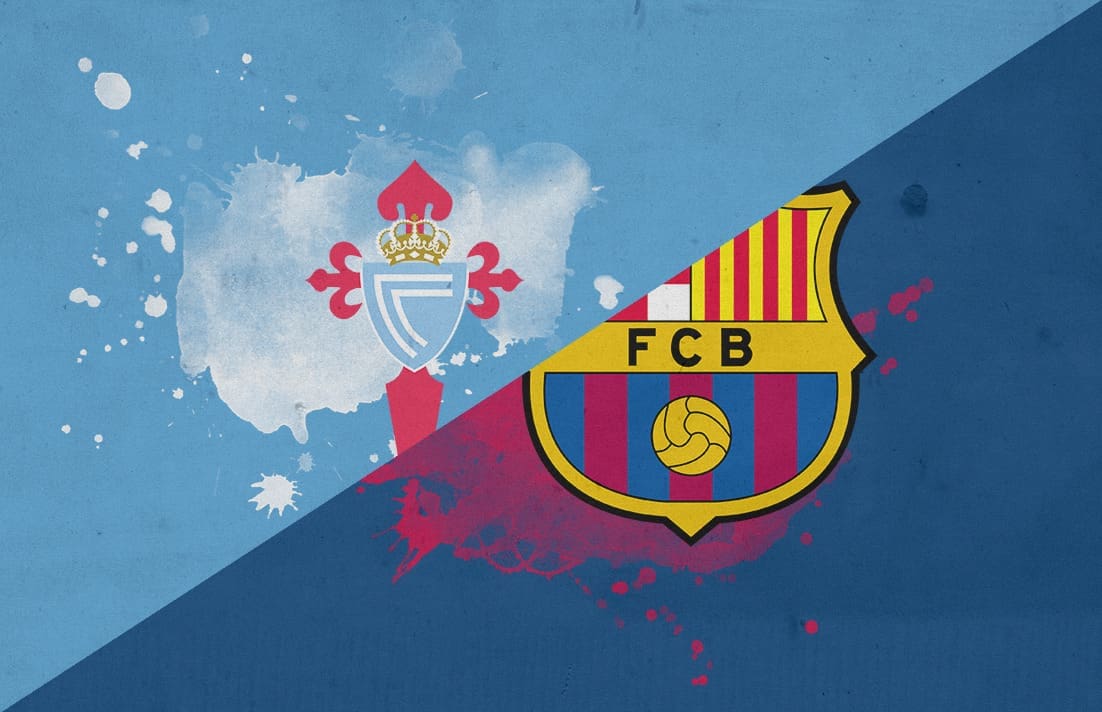



Comments